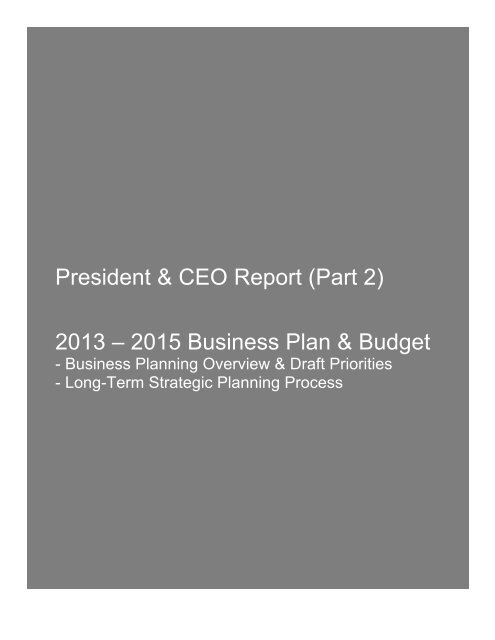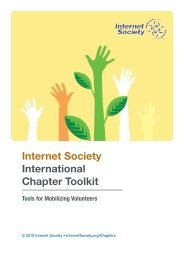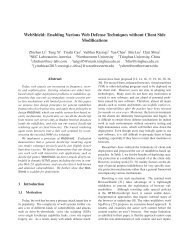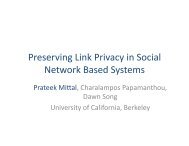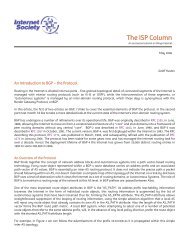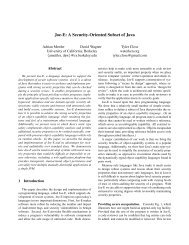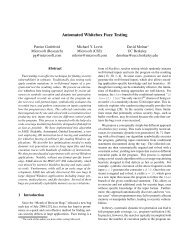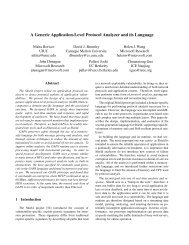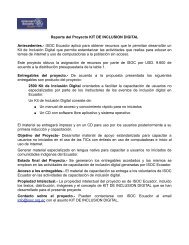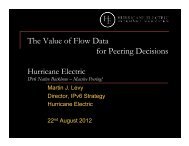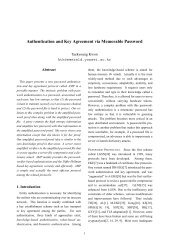President & CEO Report (Part 2) 2013 â 2015 ... - Internet Society
President & CEO Report (Part 2) 2013 â 2015 ... - Internet Society
President & CEO Report (Part 2) 2013 â 2015 ... - Internet Society
- No tags were found...
You also want an ePaper? Increase the reach of your titles
YUMPU automatically turns print PDFs into web optimized ePapers that Google loves.
<strong>President</strong> & <strong>CEO</strong> <strong>Report</strong> (<strong>Part</strong> 2)<strong>2013</strong> – <strong>2015</strong> Business Plan & Budget- Business Planning Overview & Draft Priorities- Long-Term Strategic Planning Process
!"#$%!"#&'()*+',-.-/'0/122)2*'3.-4.)-5'126'78418-*)9'0/122)2*'04:9-;;'!"#!$%#!&''(!#%)*!'+#',$'-'.!%//-01)2%3'+4!'5'-4!3$-''!4'%-#.!6789!'(:%:'#!)(!%!20-'!'13'(#)5'!#3-%3':);!/+%(()(:!/-0;'##!%(*!3%0-!6789A!!!B$)#!)(;+?*'#!%!&-0%*!;0(#?+3%3)0(!)(#)*'!%(*!0?3#)*'!0?-!2'2&'-#$)/!%(*!;022?()34A!!!B$)#!4'%-.!)(!+)('!,)3$!/%#3!*)#;?##)0(#!,)3$!3$'!C0%-*.!,'!&'+)'5'!)3!)#!)2/'-%3)5'!3$%3!,'!'2&%-!3$)#!%:'(*%!)3'2!DE6FG!)#!#'5'-%+=>0+*H!- I'5)',!3$'!$):$=+'5'+!J!4'%-!>)(%(;)%+!0?3+00-02!3$'!C0%-*!0(!#3-%3':);!/-)0-)3)'#!>0-!KLMJ!- 7?//0-3!30!205'!>0-,%-*!,)3$!3$'!+0(:=3'-2!#3-%3':);!/+%(()(:!%;3)5)34!%(*!,0-0-!(0(=-';?--)(:!*)#3-)&?3)0(!0>!>?(*#!>-02!P6I!!Q'!$%5'!/-'5)0?#+4!/?3!)(!>-0(3!0>!3$'!C0%-*!>0-!40?-!-'5)',H!- %!*0;?2'(3!0?3+)()(:!;?--'(3!3$)('-'(;'G!- %!/-0/0#%+!30!,0-8/::?'!"#$%&$'!()!"#*+!"#(#,*!-,).(/!6(!7'/3'2&'-.!P6I!)#!'1/';3'*!30!/-05)*'!%!>0-';%#3!0>!)3#!;0(3-)&?3)0(#!30!6789!3$-0?:$!KLMSA!"#!)(!3$'!/%#3.!3$)#!>0-';%#3!,)++!$%5'!%!+%-:'!)2/%;3!0(!6789@#!+'5'+!0>!/-0:-%2!*'+)5'-4!%(*!:-0,3$A!P6I!3'(3%3)5'+4!>0-';%#3#!%!#+0,)(:!)(!3$'!:-0,3$!0>!;0(3-)&?3)0(#!30!%(!)(;-'2'(3%+!TMAS!2)++)0(!/'-!4'%-A!!B$)#!#+0,'-!:-0,3$!)(!;0(3-)&?3)0(#!30!6789!)#!>-02!%!#+0,)(:!0>!:-0,3$!0>!3$'!A8IN!-'5'(?'.!;$%(:'#!)(!3$'!-':)#3-4=-':)#3-%-!+%(*#;%/'.!%(*!>-02!%(3);)/%3'*!#/'(*)(:!0(!3$'!AXN8YA8XN!%(*!6WX!30/!+'5'+!*02%)(#A!B$'-'!%-'!0//0-3?()3)'#!>0-!$):$'-!P6I!;0(3-)&?3)0(#.!&?3!,'!/-'>'-!30!&'!;%?3)0?#!)(!3$'#'!'1/';3%3)0(#A!!6789!,)++!;0(3)(?'!30!%::-'##)5'+4!/?-#?'!03$'-!>?(*)(:!'>>0-3#!>0-!2?;$!0>!)3#!:-0,3$!)(!KLMJ!%(*!&'40(*A!B$)#!%+3'-(%3)5'!>?(*)(:!:-0,3$!*'/'(*#!0(!>0?-!%-'%#!0>!>0;?#H!MA 6(;-'%#'!)(!8-:%()Z%3)0(!U'2&'-#$)/!;0(3-)&?3)0(#.!%(*!30!%!+'##'-!*':-''!0(!6(*)5)*?%+!U'2&'-!W?'#!%(*!W0(%3)0(#[!KA 7/0(#0-#$)/#!0>!0-!3$'!W'/+04!J^L!%(*!6_!'>>0-3#A!!B$'!#3-)*'#!%+-'%*4!2%*'!)(!KLMM!%(*!'1/';3'*!)(!KLMK!,'-'!#$0,(!'%-+)'-!)(!3$)#!-'/0-3A!8?-!202'(3?2!%(*!/)/'+)('!%-'!&03$!;+'%-+4!&?)+*)(:A!!Q'!>?++4!'1/';3!3$'!:-0,3$!)(!6789=
!"#"$%&"'()"*"#+"(&,(-,#&.#+"(.#(&/"(0+&+$"1((2,3"*"$4(%&(&/.5(6,.#&(.#(&/"(7"%$4(3"(%$"(5,8"3/%&(-%+&.,+5(3.&/($"56"-&(&,(%#&.-.6%&.#9(-,#&.#+"'(:;;?:4(%A5,$A.#9(&/"(0+BB(%##+%B(.86%-&(,0(&/"(>;?>(/.$"5(.#(CDEF(3.BB($"T+.$"(*.$&+%BB7(%BB(,0(&/"(>;?:(.#-$"%5"(.#(@C)(-,#&$.A+&.,#1((((R/.5(8"%#5(CDEF(8+5&(-%$"0+BB7(6$.,$.&.U"(%#'(%B.9#(,+$(-,$"(6$,9$%85(3.&/(,+$(H.55.,#1(V"(3.BB(6+$5+"(&/.5(6$.,$.&.U%&.,#(%#'(%B.9#8"#&(3.&/(&/"(L,%$'(B"%'.#9(+6(&,(&/"(>;?:W>;?X(L+5.#"55(@B%#(6$"5"#&%&.,#(.#(E-&,A"$4(%#'(3"("J6"-&("J6"#'.&+$"5(.#(8%#7(,0(,+$(-+$$"#&(%$"%5(,0(0,-+5(&,(9$,3(%&(%(5B,3"$($%&"(.0(#,&($"8%.#(5&%AB"1((I,$(&/"(6"$.,'(>;?:W>;?X4(3"("J6"-&(,+$(-,88.&8"#&(&,(&/"(CYRI(&,(-,#&.#+"(%&(.&5(-+$$"#&(B"*"B(,0(%A,+&(Z>(8.BB.,#(.#-B+'.#9(-%6.&%B.U"'(&,,B5('"*"B,68"#&1((E+$(0,-+5(,#(#"3(%$"%5(5+-/(%5("8"$9.#9(-,+#&$7(%-&.*.&."5(+#'"$(,+$()"9.,#%B(5&$+-&+$"4(9$%#&(%#'(56,#5,$5/.6('"*"B,68"#&4(%#'(P"6B,7:[;(3.BB(A"(.86,$&%#&(A,&/(%5(8"%#5(&,("J6%#'(CDEFQ5(.86%-&(%#'(%5(6,&"#&.%B(5,+$-"5(,0(0+#'"'(9$,3&/1(V"($"8%.#(-,88.&&"'(&,(&/"5"(%$"%54(%5(3"BB(%5(,+$(&$%'.&.,#%B(%$"%5(,0(@+AB.-(@,B.-74(D&%#'%$'5(\(R"-/#,B,974(R$+5&(\(C'"#&.&74(%#'(F/%6&"$5(\(H"8A"$5/.61((D&.BB4(%5(6$"5"#&"'(.#(&/"(#"J&(5"-&.,#4(3"(/,6"(&,(&%G"(%'*%#&%9"(,0(-+$$"#&(%#'(0+&+$"(,66,$&+#.&."5(&,(8%G"(%#(.86%-&(,#(,+$(H.55.,#(&/$,+9/(,&/"$(0+#'.#9(5,+$-"5(&/%&(8%7(A"(8%'"(%*%.B%AB"(.#(&/"(#"%$(0+&+$"4(.#-B+'.#9(%(#,#W$"-+$$.#9(0+#'5('.5&$.A+&.,#(0$,8(@C)(,0(+6(&,(Z?;H(]DP1((!"#$%&'())*#+,-(#.,/*01)*2(1*"#,3#.,4"00*25&,677")1(#*1*&0,(R/$,+9/(&/"(I.#%#-"(F,88.&&""4(3"(3.BB(%B5,($"*."3(&/"(,66,$&+#.&."5(%#'(&$%'",005(&/%&(
!"#$%&$'(&)&*+&,$-(.!$*.*/(&01((2*3$(&).1(0&)$&4'&0+&,$+.$%&$"5"26"%6&$-(.!$789:$$;/=?@$!2662.*$2*$%126+/1'$789$(&)&(5&)$+.$8ABC:$$D"*"3&!&*+$(&0.!!&*,)$+
To: Board of TrusteesDate: 10 July 20122Subject: <strong>2013</strong> – <strong>2015</strong> Business PlanIntroduction:The <strong>Internet</strong> <strong>Society</strong>’s Board Work Plan for 2012 calls for the <strong>2013</strong>-<strong>2015</strong> Business Plan and <strong>2013</strong>Budget to be approved at the Board meeting scheduled for October 20-21, 2012. The final BusinessPlan and Budget isdue to the Board of Trustees on September 29.Our practices for creating the Business Plan and budget are long established and we are nowincorporating the Finance Committee into our planning. Inn addition, a more in depthlong-termstrategic review (done roughly every three orfour years) is also gettingg underway. It will span thisyear and next and an update will be sent to the Board shortly.In order to achievee our mission, we must be an organisation of global influence and action. As such,we intend to focus on key impacts that will make a substantial and measurable difference globally.For the 2012-2014planning cycle, ISOC organized its business plan around four strategic, cross-organizational objectives, and established 2-3 key impactss with supporting goals foreach. They are:A. Fostering anopen, innovative, and trusted <strong>Internet</strong>t worldwide.B. Advancing policies and strategies thatt strengthen the <strong>Internet</strong>’s growth and evolution.C. Enabling a vibrant organisation and vital global community to advance the <strong>Internet</strong>’s future.D. Empoweringpeople to achieve humanpotential through unencumbered <strong>Internet</strong> use.For ease and to aidthe incoming Trustees, Appendix I has the high level frameworkfor our 20122Business Plan andthe four Strategic Objectives in more detail. The full 2012 Business Plan isavailable here: ://www.internetsociety.org/who-we-are/organisational-reports/business-planPurposeThe purpose of thisdocument isto get someearly input from the Boardfor some ofour more globalpriority areas and to share an update on some of the key financial considerations. Perhaps mostimportantly, are there areas missing or areaswhere you think we should be active at a global level?<strong>2013</strong> Global Priority Areas (high-level introduction)We expect to havea focused set (4-6) of high-level/high-impact priorityareas we believe will becritical to advance.While we are still in the process of evaluating ideas, our draft list currentlyincludes (and note 1 or 2 may not rise to the top, but couldd still be advanced by ISOC):1. Online Collection and Correlation of Identifying Data2. Digital Content3. Network Confidence4. <strong>Internet</strong> Governance5. <strong>Internet</strong> and Human Rights6. Traffic /Bandwidth ManagementThesee areas join our departmental, and coreoperating and financial goals for revenues, members,chapters and Regional Bureaus, and all are expected to continue to show ambitiousgrowth. Theyare not included in this update as we are searching for input on some of our newer strategic areas.We will have manydraft goals for our AugustBoard meeting, and some are alreadyunder reviewwith the Finance Committee.<strong>2013</strong> Budget Planning 7-2-2012.docx
<strong>2013</strong> Flagship Efforts (high-level introduction)In addition, just as this year we had ISOC’s 20 th Anniversary, a Global INET and, launched the Hallof Fame, next yearwe will also have several flagship efforts. These are aimed at substantiallyadvancing our impact in key areas as well asbuilding ourr visibility. Our draft currently includes:1. “This is Our <strong>Internet</strong>” <strong>Report</strong>2. “<strong>Internet</strong> Week”Annual Campaign (takingg over the IPv6 Launch week slot)3. <strong>Internet</strong> Hall of Fame/GlobalINET4. Deploy 360<strong>2013</strong> Global Priority Areas (for discussion)Staff’sdiscussionss have been driven, in part,from a review of the possible trajectories for the<strong>Internet</strong> as we envisioned in our“Future <strong>Internet</strong> Scenarios” strategic exercise of a few years ago.They also took intoaccount feedback from many stakeholders as part of our Globall and RegionalINET’ s, chapter meetings and workshops, aswell as through many other and variedfeedbackmechanisms.Whilewe are still inthe processs of evaluatingideas, and continue to incorporate broader stakeholderinput into our planning, we wantto take this opportunity too share our current thinkingaround <strong>2013</strong>-<strong>2015</strong> Global Priority Areas. What follows areabstracts – more contextt is available if helpful. And,please send in anycomments, thoughts or questions – it will help our planning.1.2.3.Online Collection and Correlation of Identifying Dataa – The collection and useof identifyingdata is one of the fasting growing sectors of the <strong>Internet</strong> economy. As storage becomescheaper anddata processing and transmission getss faster and easier, more and more userinformation is being preserved and used for marketing purposes and user profiling. Every timewe log-in weleave a digital footprint. In order to preserve privacy and unhindered access tocontent and services users must have the ability to evaluate andmake choices based on anunderstanding of the terms offered. Further, policy makers, regulators and implementers mustall be fully aware of the consequencesfor end userss and take these into consideration whencrafting solutions for data handling. In <strong>2013</strong>, the <strong>Internet</strong> <strong>Society</strong>would take a strongleadership role in educating and empowering users to make informed choicesabout the use oftheir identifying data, raising substantive ethical questions in technical and policy forums, andengaging industry and developers on the consequences of implementation choices.Digital Content – The <strong>Internet</strong>’s open architecture and generativee nature haveencouragednew forms of content creation by a greatly expanded range of actors. However, the manner inwhich ongoing tensions are resolved between digital content business models, intellectualproperty rights, technical solutions, andusers’ rightss and ability to access content will haveafundamental impact on the future of the<strong>Internet</strong>. Across the business, policy and technicalspheres, we are still far from solutions that reconcilee the <strong>Internet</strong>’s fundamental character andits empowerment of new forms of usercreativity with the desire of content creators toreasonably manage rightsassociated with their creations. Our objectives in this area wouldbe to shift the debate fromenforcing intellectual property rights topromoting innovativebusiness models or approaches adapted to the realities of the <strong>Internet</strong>, to advance nationalpolicy approaches and international regimes that support users’ rights and recognize theborderless <strong>Internet</strong> environment. We will spearheadd multi-stakeholder dialogue in the debateon digital content and intellectual property rights.Network Confidence - Network confidence lies at the crux of users’ trust in the security andreliability of on-line interactions. And, a broad rangee of stakeholders, includingusers,business, government, and technologists all have an influence and role to play in this sphere.Our objectives in this areaa include ensuring end users can accurately assess the security andreliability of their transactions and make informed trust decisions, advancing the developmentand deployment of standards and technology that enable network confidencee from the network<strong>2013</strong> Budget Planning 7-2-2012.docx
layer to the application layer, and advocating for public policies that enable and strengthennnetwork confidence while respecting the architecture of the <strong>Internet</strong> and userss rights.4.5.6.<strong>Internet</strong> and Human Rights – The ArabSpring thrust into sharp focus the roleof the <strong>Internet</strong>as a facilitator of human rights and theability of government to thwart expression bysuppressing access. While the eventshelped affirmthe need for preserving an open <strong>Internet</strong>in many quarters, it also galvanized concerns across a range of political entities threatenedbyit. In light of both the new opportunitiesand challenges, we would advocate for thecontinuation of an open, global and accessible <strong>Internet</strong> as an instrument in fulfilling aspirationsfor human rights and freedom of expression. Our objectives include promoting and defendingusers’ rights to “seek, receive, and import information and ideas” ” through the <strong>Internet</strong>,demonstrating the linkages between the underlying architecture of the <strong>Internet</strong> and humanrights, and ensuring governments uphold the duty too protect citizens’ right to expressthemselves through unencumbered <strong>Internet</strong> use.<strong>Internet</strong> Governance - While significant progress has been madeover the past several yearsto advance a multi-stakeholder <strong>Internet</strong> ecosystem, the actions of governments and thegrowing impact of industrydecisions on the ecosystem and the user experience continues toaffect the “influence landscape”. We are experiencing an environment wheree the <strong>Internet</strong>model and multi-stakeholdder cooperation are both widely celebrated and under pressure tochange. Some concerns include trends toward multiple forms off “territorialization,” e.g.corporate walled gardens, non-neutral networks, and intellectual property restrictions, as wellas governmental surveillance and security. Amongg our objectives, we will advance <strong>Internet</strong>-and standards development processes, empowering end users with an understanding of the<strong>Internet</strong> ecosystem and governance processes so they can organize responses to global andsupportive policy outcomes by facilitating governmental engagement in <strong>Internet</strong> governancelocal issues, and promotedecision-making by industry that supports the fundamental tenantsof the <strong>Internet</strong> Model.“Traffic /Bandwidth Management” – The best-effort, end-to-end delivery of content andservices is facing new threats as bandwidth-intensive user offerings heighten both the tensionand confluence between access and content industries. There is renewed pressure fromsome accesss providers tomonetize offerings basedd on the control of servicess their users areaccessing. Policymakershave increasing pressuree put on them by proponents of “senderpays” and circuit-like Quality of Servicee (QoS) models, who argue they would be animprovement over the current <strong>Internet</strong> model. Thesee ideas have the potential to move us awayfrom an openand permission-free <strong>Internet</strong>. In <strong>2013</strong>, the <strong>Internet</strong>t <strong>Society</strong> has an opportunity toengage the wider <strong>Internet</strong>t community to discuss these issues and provide clarity to theconversation.Again, we are still in the processs of evaluating ideas, and continue to incorporate broaderstakeholder input. Note that some of these may not scalee up in importance or impact. We lookforward to your input - it will be helpful in ournext steps.Our ASKFirst, input on the above. And, are there areas missing orr areas wheree you think weshould beactiveat a global level – areas where we canhave a strategic impact?<strong>2013</strong> Budget Planning 7-2-2012.docx
<strong>2013</strong> Flagship Efforts (for discussion)In addition to establishing a set of “Global Priority Issues” ”, staff is alsoworking to define a new setof “Flagship Efforts” to advance our impact inkey areas.At present, our thinking includes:1. “This is Our <strong>Internet</strong>” <strong>Report</strong>: Many non-profit organisations and think tanks are highlysuccessfull in garnering global attention to their cause by issuing annual or bi-annual reportsthat present data and related analysis on key issues it seeks toaddress with stakeholders.Examples include the World Economic Forum’s “Global Competitiveness <strong>Report</strong>,”Transparency International’s “Corruption Perception Index,” and the World Wildlife Fund’s“Living Planet <strong>Report</strong>,” among many others. Suchh reports provide focal points to advancekey messages, reinforce their leadership, and leverage their advocacy impact by placingpowerful information into the hands of a broad range of influencers. They also serve as avehicle forfunding and membership engagement.In <strong>2013</strong>, our objective would be to launch the development of such a report as a flagshipasset of the <strong>Internet</strong> <strong>Society</strong>. While we are still refining the concept, including the specificdata that would be collected, we would seek to position the “This is Our <strong>Internet</strong>” <strong>Report</strong>(working title) as the world's leading analytical report on the health and openness of the<strong>Internet</strong> within 3 years.2. “<strong>Internet</strong> Week” AnnualCampaign: The success of World IPv6Day and IPv6 Launchdemonstrated the usefulness of galvanizing the world’s attention on key <strong>Internet</strong> issuesthrough a specific themed day or week. We currently envisionn using an “<strong>Internet</strong> Week”format to provide a focal point for keymessaging on one or more “global focus issues”. Thethematic campaign will highlight key focus areas globally. Thiscampaign will includemobilizing a broad set of resources with our Chapters, Members, and partners to promoteand celebrate what matters most about the futuree <strong>Internet</strong> and the ultimate impact to the enduser. An early leader for <strong>2013</strong> is: “This is Your <strong>Internet</strong>” with individual days dedicated topossibly: Privacy-Digitaal Footprints, Security (DNSSEC – RPKI), <strong>Internet</strong> Governance, etc.3. <strong>Internet</strong> Hall of Fame / GlobalINET:The <strong>Internet</strong>t Hall of Fameand GlobalINET were highlysuccessfull as a flagshipinitiative andevent for thee <strong>Internet</strong> <strong>Society</strong> in 2012. In our <strong>2013</strong>-<strong>2015</strong> Business Plan wewill incorporate the <strong>Internet</strong> Hall of Fame as an annual flagship effortand the Global INET asour bi-annual flagship event.4.Deploy 360 – Deploy 360 works withthe first adopter community to leverage knowledge ofnew technology deployment and create resourcess that are easy to understand and quicklyactionable by the greater operations community too deploy key <strong>Internet</strong> technologies. Deploy360 also serves as a valuable ISOC resource for supporting the general operator and usercommunityin the adoption of new standards and as an effective tool to spread awareness ofIETF outputs.Regionalization and Regional Focal AreasWe intend to advance our regionalization strategy in <strong>2013</strong>-<strong>2015</strong> by bolstering the effectiveness andempowerment of our Regional Bureaus. Weare currently consulting each Bureau Director todetermine the specific issues ofregional importance that might requiree <strong>Internet</strong> <strong>Society</strong> actionbeyond any global priorities we may establish. We are also evaluatingresourcing and expansionstrategies, including the possibility of launching a North Africa/Middle East Bureau in <strong>2013</strong>.Again, we are looking for your comments andfeedback.<strong>2013</strong> Budget Planning 7-2-2012.docx
Financial Update – Key DevelopmentsISOC staff continue to work withthe FinanceCommittee to review Operating reserve levels and thiswill bebrought by the Finance Committee to the Board forr approval. We are also heavily vested in aprocess with PIR ( and 3 rd parties given governance and tax implications) to determine what funds itmight“release” to ISOC/PIR. Staff’s report iswith the Finance Committee and we are also meetingwith the PIR staff and Board to get their position/views. This will be available for our upcomingBoardmeeting as well. In the meantime, weare providingg you with thefollowing update as theseeare two critical areas.PIR Contributionsto ISOCIn its 2012-2014 Plan, PIR projected an increase in its annual contribution to ISOC from $26.5millionin 2012 to $28.0 million in <strong>2013</strong>. According to PIR’s budget timeline and PIRBoard meetingschedule, formal approval of their <strong>2013</strong> budget is scheduled for October 12. As is typical, ISOCrequests an earlierr indication oflikely PIR contribution for <strong>2013</strong>, but PIRmay only have July 20122financials to base such a projection. Therefore, we will need to rely only on the $1.5million increase.We estimate that this increase will be used tocover the full year annualized costs of the new hiresbrought on in 2012, hence our own revenue efforts will bee central to our own growthplansISOCContributions to IETFIETF budget timingis similar. The IAOC will likely approvee the IETF/IASA budget (for submissiontoISOC) in mid-September. For preliminary ISOC budget purposes, we expect the request for ISOCfunding to the IETF(in addition to securing meeting host/sponsorships) to be about $2 million(slightly less than the current forecast for 2012).ISOC-Generated RevenueThe primary ISOC-Generated Revenues include:a. IETF Host and Meeting Revenueb. Org Memberships/Platinum Contributionsc.Individual Memberships/Donationsd. Sponsorships (identifiedd by programmatic areas: NDSS, ITE, DO, IL, etc.)e. Grants (e.g, the AXIS grant from the African Union, the US State Department grant)f. Registration and Fee Revenue (largely IETF and NDSS)In discussing ISOC-GeneratedRevenue, thetiming of revenue recognition and the cost impacts ofcertain grants and restricted sponsorships will be addressed (also see cost implications below).One area of growing program expenditures that will require special attention is grants and donor-directed sponsorships. As has been seen with the recent AXIS grant from the African Union, bothinternal staffing and external program costs often absorb a large portion of the increase in grantrevenues. Therefore, the <strong>2013</strong> program expense budget will need to carefully distinguish costincreases for both existing grant awards and any budgeted <strong>2013</strong> grantt awards.Each of these revenue areas will be further developed, and is under review by Membership,Resource Development and Grants personnel under Walda Roseman (<strong>Internet</strong> <strong>Society</strong> COO).Fiscal ChallengesAt thispoint in time, financial challenges are expected to be: Managing an apparentlyslowing growth in PIR contributions (caused by additionalinvestment in .ORG marketing, registry industry changes, and investments over the nexttwoyears in .NGO and IDN launch costs); Increasing ISOC-generated revenues while planning for any concurrent expenses; Managing our ongoing programmaticefforts in thee face of a base level of increases; PrioritizingStrategic Objectives, including new, maturing, and end-of-life programs.<strong>2013</strong> Budget Planning 7-2-2012.docx
OtherTopics andConsiderationsOthertopics, largely financial in nature, will be addressed as part of theoverall planning process.Most notable are the Public Support Test, reserves and investment decisions, the Open <strong>Internet</strong>Endowment, and 2014-<strong>2015</strong> Outlook as partof the 3-yearr Business Plan.We will provide an update on all these financial areas for the Board meeting.In ClosingThis document is meant to kick-start a discussion and we tried to provide some context to get thatstarted. If there ismore information needed or somethingg missing, please do let me know. Asalways we look forward to your comments and thoughts.Best regards,LynnAttachment - APPENDIX I:2012 – 2014 Businesss Plan High level Outline<strong>2013</strong> Budget Planning 7-2-2012.docx
APPENDIX I:2012 – 2014 Business Plan High level OutlineOverview of FourStrategic Objectives (above)In order to achievee our mission, ISOC must be an organisation of global influence and action. Assuch,we intend to deliver on key impacts that will make a substantial and measurable difference.For the 2012-2014planning cycle, ISOC organized its business plan around four strategic, cross-organizational objectives. They are:A. Fostering anopen, innovative, and trusted <strong>Internet</strong>t worldwide. We are committed toadvancing the underlying open and interoperable architecture of the <strong>Internet</strong>, and its distributedand collaborative means of management and development, as these principles are essential forfostering a stable, open, and trusted <strong>Internet</strong> upon which innovation can flourish.B. Advancing policies and strategies thatt strengthen the <strong>Internet</strong>’s growth and evolution. We aimtoinfluence policy makers, civil society, industry, and others to advance <strong>Internet</strong> policies andstrategies that uphold the critical principles of openness, user-centricity, and stakeholderparticipation.C. Enabling a vibrant organisation and vital global community to advance the <strong>Internet</strong>’s future.We aim to further engage our members and the publicc towards positive action, as well ashelping a new generation of<strong>Internet</strong> leaders, contributors, and innovators to emerge.D. Empoweringpeople to achieve humanpotential through unencumbered <strong>Internet</strong> use. We willaim to advancethe access and use of the <strong>Internet</strong> on an open, nondiscriminatory basis, andempower individuals and communities, ncluding the vulnerable and underserved, to maximizethe transformative opportunities the <strong>Internet</strong> enables.<strong>2013</strong> Budget Planning 7-2-2012.docx


